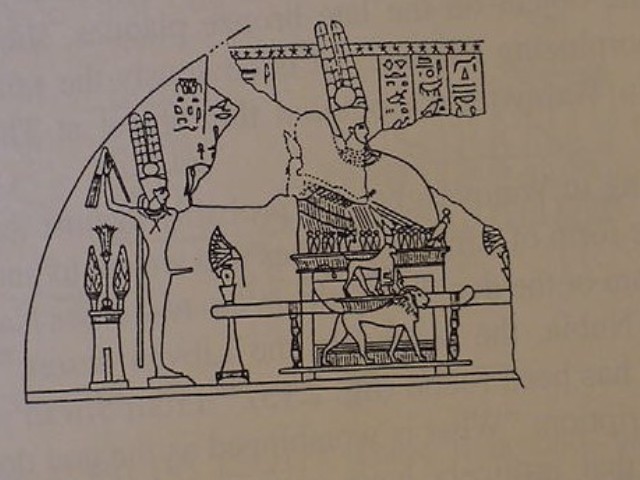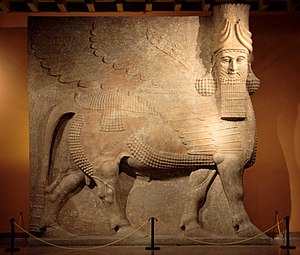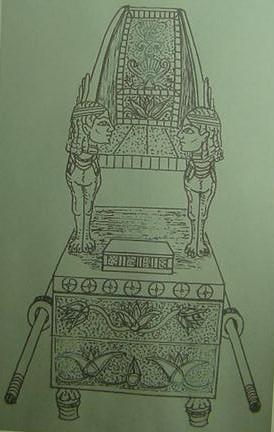Ideas, hints, and tips for designing the Ark...
I've got some ideas about the Ark that I thought may be helpful. This is probably going to be a very long post, though, since there's a lot to consider regarding designing the Ark of the Covenant. Anyhow, let's begin...
First off, I agree that it wouldn't be a six-pointed star on the Ark, and I've discovered the symbol they most likely *would* have used in it's place:
I read somewhere that in David and Solomon's time, it wasn't the six-pointed star we know today that was in use, but rather a five-pointed star instead that was used as the royal seal for David and Solomon's house and nation.
According to an ancient Hebrew legend, King Solomon wanted to be a very different kind of ruler from his father David. One night he magically summoned the archangel Raphael using a magic ring that could also conjure elementals. (In the Islamic version of the story it's Djinn, not elementals.) He asked the angel by what symbol he should rule his people and Raphael gave him a seal with a five-pointed star upon it. To Solomon's surprise, it was the same star his father ruled under, and that was when he realized he should not try to be better than David, but rather just as good of a ruler as he himself was able.
Since the five-pointed star symbolized the five elements, Solomon gained a great deal of power that day... over Fire, Water, Earth, Air, and Spirit.
I don't know if they would've used the five-pointed star on the Ark, as it wasn't mentioned in the Bible that the Ark had any decoration other than the two Cherubim, but it's possible they may have used it, as well as some other motifs borrowed from Egypt, since some believe it was in Egypt that Moses learned the secrets to constructing the Ark from some Egyptian high priests.
Another good symbol for the 12 Tribes of Israel is the twelve-pointed star of the Zodiac, but it had Babylonian origins so it wouldn't have been in use at all amongst the Hebrews, if they used it at all in any capacity, until after their Babylonian captivity, and by then the Ark was lost. So I'd say that if any star was used, it would have definitely been the five-pointed star.

One reason why the five-pointed star was dropped in favor of the six-pointed star is that in modern times the five-pointed star is popularly seen as an occult symbol rather than a religious/political one. The irony is that the six-pointed star was the one favored by the famed occultist Aleister Crowley for use in his more sinister magical rituals. And in America, we've seen that the five-pointed star has very positive roles as a political symbol indeed. It's used in the armed forces (like the Army), the design of the Pentagon, and even in some of the layout of Washington D.C. itself. So, I suspect that back in Moses' time it was also seen as having a positive role. America was founded in part by a lot of Freemasons, who use the five-pointed star as one of their symbols. And, it is less commonly known that Freemasons trace their rituals back to Solomon's Temple and ancient Egypt. The Knights Templar held similar ideas, as well. So if you are going to use a star, I would go with the upright, five-pointed star.
Curiously, in symbolism, the six-pointed star is a symbol comprising both male and female characteristics, while the five-pointed star is decidedly female. In a way, the widespread use of a feminine symbol in America makes sense, as we do live in a land crowned with a statue of the goddess of Liberty! We do see the six-pointed star, however, in the shape used by some police badges and in various symbols relating to law-enforcement. Fitting... since the law applies to everybody, male and female alike. I read somewhere that one very important religious reason behind Israel choosing the six-pointed star was to represent the angel Ariel, which is the national angel of the Israeli nation. It seems Ariel is supposed to be both male and female, so it does make sense. However, as we know... it was not the "original" star of David and Solomon. Therefore, that's the reason I've made the suggestion that I did about this.
The second consideration is that the Ark was half based on Egyptian design. Your Ark uses Babylonian-style Cherubim, which are beautifully done, but in the historical sense would be unknown to the Hebrew prior to their captivity in Babylon. Just before the Exodus, they had lived their whole lives in Egypt, and so Moses would have used a design familiar to them, not a design from a land that.. at the time... was very far removed from the affairs of his people. And, before they lived in Egypt, they dwelled in Canaan, so still we don't see any strictly Babylonian motifs entering the picture until much later in history.
And, yes, those Cherubim were also used in Persia, but Persia did not enter the Biblical scene, until they rescued the Hebrew from Babylonian tyranny. However... the Lammasu Cherubim could well have been used in place of the Babylonian, Persian, or Egyptian designs. This is because the Lammasu were a part of Canaanite tradition stretching as far back as when Jonah lived in Nineveh, which was in Sumeria back then, which is what eventually became Babylonia. If Moses wanted to stick to his Canaanite roots, he would have used the Lammasu as his Cherubim. If he wanted to create something new, he may have gone with the Egyptian style that was popular during that time. It is my belief, however, that Moses blended the old with the new, cleverly.
Here is a picture of a stone Lammasu, taken from an archeological exhibition:
And here is an artist's conception of a bit more fanciful guardian Lammasu:
Here are some pictures that illustrate what various Egyptian arks looked like.
It is evident that in Egypt different gods and goddesses had sacred arks, in which sacred relics of the faith were kept. Those relics varied with the deity:
An artist's conception of an Egyptian Ark:
(One thing about these arks, is that you can tell the kind of god or goddess it is dedicated to by it's design, and often by the style of it's Cherubim, who more often than not bear the likeness of the deity the ark was dedicated to.)
A realistic rendering of an Egyptian Ark based on how a real one would look:
(This is identical to the artistic version above, but is designed to show what the vessel would looks like as a real artifact, which gives one a good idea. By the style of the Chrerubim, this Ark was dedicated to the goddess Hathor.)
A re-enactment of an Egyptian ritual involving another type of Ark:
(This one is the least like the Ark that Moses would have created. Instead of Cherubim, it uses Horus falcons, which is completely not the Hebrew style. This Ark was clearly exclusive to the worship of Horus, son of Osiris and Isis.)
The goddess Isis sitting upon the Mercy Seat of an opened Egyptian Ark:
(Look closely, and you'll see a five-pointed star like the one in the legend! It is just beneath Isis' feet. I'll bet this is where David and Solomon got it from, as handed down undoubtedly by Moses from all that time he spent in Egypt.)
Here is another interesting deisgn, with more Sphinx-like Cherubim upon it:
(The logic behind the use of Sphinx-like Cherubim was that, since often in Egypt the Pharaoh was a living god, you could always make the Cherubim in the image of the current Pharaoh and use that particular Ark for his worship.)
This rather rough illustration depicts the Ark literally as being God's throne:
(I think this is taking the term Mercy Seat too literally. While I could see the idea of the Ark as being a throne for a real flesh-and-blood god or goddess very plausible, I don't think the Ark was taken to this level of ornate design.)
Lastly, here is an illustration from an Egyptian Tomb that may be of interest:
(It depicts the god Amon Ra literally enthroned upon an ark. The faces of the Cherubim have been chipped away, but by their outline I suspect they were made in the god's image, which is consistant with Egyptian Cherubim design.)

Given that an Egyptian style may well have been crossed with a Canaanite style, I think if we knew what the Cherubim on Moses' Ark really looked like it would go a long way towards revealing how they viewed the god they were dedicated to. Male? Female? Androgynous? Hermaphroditic? It is not at all an inconceivable notion that any of these could be the case, since God created Man and Woman in His image according to the Bible. So, does that make God Male and Female? Other than seeing God, which is impossible while alive, the only clue may lie in the faces of the Cherubim on Moses' Ark. Which is why I truly do believe humanity may not be ready for it. After all, imagine a relic of immense power that not only may have been a terrrible weapon but also may have been able to teach humans about the nature of God Himself! And so...
What do I think Moses did? The Ark's Cherubim were described as having very demonic features in most accounts, so he clearly used Lammasu with faces as he imagined the face of God to be like: wrathful, terrible. The basic design of the Ark was likely based, otherwise, on the Isis Ark; the Mercy Seat is well documented. Thus, the Ark bore the five-pointed star adopted by Moses for Israel's emblem. That's the most historically accurate idea of how it looked.









